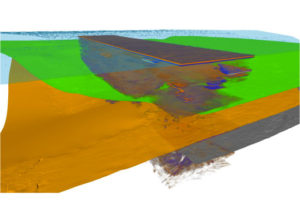 Volume rendering is a technique used to display a 2D projection of a 3D discretely sampled data set. To render a 2D projection of the 3D data set, one first needs to define a camera in space relative to the volume. Also, one needs to define the opacity and color of every voxel. This is usually defined using an RGBA (for red, green, blue, alpha) transfer function that defines the RGBA value for every possible voxel value.
Volume rendering is a technique used to display a 2D projection of a 3D discretely sampled data set. To render a 2D projection of the 3D data set, one first needs to define a camera in space relative to the volume. Also, one needs to define the opacity and color of every voxel. This is usually defined using an RGBA (for red, green, blue, alpha) transfer function that defines the RGBA value for every possible voxel value.
A volume may be viewed by extracting surfaces of equal values from the volume and rendering them as polygonal meshes or by rendering the volume directly as a block of data. Direct volume rendering is a computationally intensive task that may be performed in several ways.
Abstract:
Seismic data play an important role in the energy industry. Companies of the oil and gas industry or in the field of geothermal energy conduct a large financial and organizational effort for the acquisition of data from the interior of the earth. Therefore, the analysis and interpretation of the data has a great importance for the economic success of these companies.
In the present work, a method for analyzing and interpreting seismic volume data, was developed. In particular, the focus is on the creation of geometries within the volume data. With those geometries, geological experts are able to analyze so called seismic faults to get information about the possible return, of this seismic fualt, of raw materials . The special feature of the developed method, is that it can be used in various visual representations of the volume data.
Related Publications
- Lux, C., Fröhlich, B., GPU-Based Ray Casting of Stacked Out-of-Core Height Fields, in: Proceedings of the 7th International Symposium on Visual Computing, LNCS vol. 6938, Springer-Verlag, Berlin, Heidelberg, pp 269-280, October 2011
- Rhadames Carmona, Bernd Froehlich, Error-controlled real-time cut updates for multi-resolution volume rendering, Computers & Graphics, In Press, Accepted Manuscript, Available online 28 January 2011, ISSN 0097-8493, DOI: 10.1016/j.cag.2011.01.007.
- Lux, C., Fröhlich, B., GPU-based Ray Casting of Multiple Multi-Resolution Volume Datasets, in: Proceedings of the 5th International Symposium on Visual Computing, LNCS vol. 5876, Springer-Verlag, Berlin, Heidelberg, pp 104-116, November 2009
- Plate, J., Holtkaemper, T., Froehlich, B., A Flexible Multi-Volume Shader Framework for Arbitrarily Intersecting Multi-Resolution Datasets, Transactions on Visualization and Computer Graphics, Volume 13, Issue 6, 2007, pp. 1584–1591
- Plate, J., Tirtasana, M., Carmona, R., Fröhlich, B., Octreemizer: A Hierarchical Approach for Interactive Roaming Through Very Large Volumes, in: Proceedings of the Symposium on Data Visualisation 2002 (VISSYM ’02), pp. 53-60
- R. Carmona, G. Rodriguez, and Bernd Froehlich. 2009. Reducing Artifacts between Adjacent Bricks in Multi-resolution Volume Rendering. In Proceedings of the 5th International Symposium on Advances in Visual Computing: Part I (ISVC ’09). Springer-Verlag, Berlin, Heidelberg, 644-655
- Jan Bender: Intuitive Creation of Fault Geometry in three-dimensional seismic volume data, submitted on June 29, 2016 to the TH Köln – University of Applied Sciences in Cologne. – IN GERMAN
